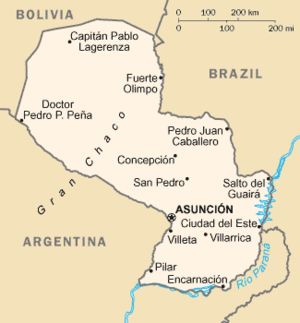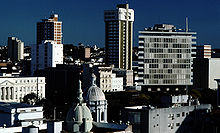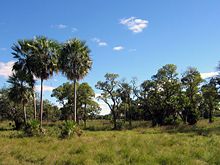Paraguay
Republic of Paraguay República del Paraguay Tetã Paraguái | |
|---|---|
| Motto: Spanish: Paz y justicia (English: "Peace and justice") | |
| Anthem: Paraguayos, República o Muerte | |
 | |
| Capital and largest city | Asunción |
| Official languages | Spanish, Guaraní |
| Government | Presidential republic |
| Nicanor Duarte Frutos | |
| Luis Castiglioni Joria | |
| Independence From Spain | |
• Declared | May 14, 1811 |
• Water (%) | 2.3% |
| Population | |
• July 2005 estimate | 6,158,000 (101st) |
| GDP (PPP) | 2005 estimate |
• Total | $28.342 billion (96th) |
• Per capita | $4,555 (107th) |
| HDI (2003) | 0.755 high (88th) |
| Currency | Guaraní (PYG) |
| Time zone | UTC-4 |
• Summer (DST) | UTC-3 |
| Calling code | 595 |
| ISO 3166 code | PY |
| Internet TLD | .py |
Paraguay, officially the Republic of Paraguay (Spanish: República del Paraguay, pron. IPA [re'puβlika del para'ɣwaj], Guarani: Tetã Paraguái), is a landlocked country in South America. It lies on both banks of the Paraguay River, bordering Argentina to the south and southwest, Brazil to the northeast, and Bolivia to the northwest, and is located in the very heart of South America. 'Paraguay' is derived from the Guaraní word 'Pararaguay', meaning, 'From a Great River'. The 'Great River' is the Paraná River, which produces the greatest amount of hydroelectric power in the world.
History
Europeans first arrived in the area in the early 16th century and the settlement of Asunción was founded on August 15, 1537, by the Spanish explorer Juan de Salazar. The city eventually became the centre of a Spanish colonial province, as well as a primary site of the Jesuit missions and settlements in South America in the 18th century. Paraguay declared its independence by overthrowing the local Spanish authorities on May 14, 1811.
In the disastrous War of the Triple Alliance (1865–1870), Paraguay lost 140,000 square kilometres (54,000 sq mi) of territory (e.g. the Misiones region) and suffered a huge loss of its male population. Tradition holds that up to two thirds or more of the adult male population was killed, but some argue that, upon analysis from historic records and census reports, this figure is greatly exaggerated.
Paraguay gained a large part of its current territory at the expense of Bolivia, in the aftermath of the Chaco War, the culmination of a long series of border disputes between the two countries. They tried to settle their claims diplomatically along the second half of the 19th century. Successive negotiations failed to produce a definitive agreement, and Paraguay established its jurisdiction by encouraging the settlement of the largely unpopulated Chaco area. By 1935, Bolivia had regrouped and was able to stop the advance of the Paraguayan army. Exhausted by a long war, and having expanded its territory considerably, Paraguay accepted the mediation of the League of Nations.
Politics
Template:Morepolitics Politics of Paraguay takes place in a framework of a presidential representative democratic republic, whereby the President of Paraguay is both head of state and head of government, and of a pluriform multi-party system. Executive power is exercised by the government. Legislative power is vested in both the government and the two chambers of the National Congress. The Judiciary is independent of the executive and the legislature.
Administrative divisions
Paraguay is divided into 17 departments, each with its own administrative capital, and one capitol district. The capitals of the departments are provided in parentheses.
 |
Geography


The southeastern border is formed by the Parana River, containing the Itaipu dam shared with Brazil. It is currently the largest hydroelectric power plant in the world, generating nearly all of Paraguay's electricity.
The local climate ranges from subtropical to temperate, with substantial rainfall in the eastern portions, though becoming semi-arid in the far west.
Economy
Paraguay has a market economy marked by a large informal sector that features both re-export of imported consumer goods to neighbouring countries as well as the activities of thousands of microenterprises and urban street vendors. A large percentage of the population derive their living from agricultural activity, often on a subsistence basis.
Paraguay's economic potential is strengthened geographically by its access via the Paraná River to Buenos Aires, Montevideo and the Atlantic Ocean. Meanwhile, Paraguay's economy is very dependent on Brazil, Paraguay's neighbour in the east, as the government created a free port on the Brazilian Atlantic coast at Paranaguá and developed a route linking the port to Paraguay. The project of the Bridge of Friendship that now spans the Paraná River between Ciudad del Este and the Brazilian city of Foz do Iguaçu. The bridge carries about 40,000 travelers daily. The selling of cheaper goods is another important source of revenue and it is still a common habit in Brazil to go to Paraguay and buy electronics there. About 60% of the GDP is from commerce with Brazil. Despite difficulties arising from political instability, corruption and slow structural reforms, Paraguay has been a member of the free trade bloc MERCOSUR since 1991.
Demographics

Ethnically, culturally, and socially, Paraguay has one of the most homogeneous populations in Latin America. About 95% of the people are mestizos of mixed Spanish and Guaraní Indian descent. The only trace of the original Guaraní culture is the Guaraní language, spoken by 94% of the population. About 75% of all Paraguayans can speak Spanish. Guaraní and Spanish are both official languages. Small groups of Ethnic Italians, Germans, Japanese, Koreans, Chinese, Arabs, Brazilians, and Argentines settled in Paraguay and they have to an extent retained their respective languages and culture particularly the Brazilians.
Paraguay's population is distributed unevenly throughout the country. About 56% of Paraguayans live in urban areas. The vast majority of the people live in the eastern region near the capital and largest city, Asuncion, that accounts for 10% of the country's population. The Chaco, which accounts for about 60% of the territory, is home to less than 2% of the population.
The country is predominantly Roman Catholic, with some Mennonite and other Protestant minorities.
Culture

Paraguayans express their culture in arts such as embroidery (aho poí) and lace making (ñandutí). Their music, which consists of lilting polkas, bouncy galopas, and languid guaranías played on the native harp. They also enjoy eating sopa paraguaya which is like a thick corn bread. It consists of many cheeses, onions, bell peppers, cottage cheese, yellow cornmeal, milk, seasonings, butter, eggs and fresh corn kernals.
The 1950s and 1960s saw the flowering of a new generation of Paraguayan novelists and poets such as José Ricardo Mazó, Roque Vallejos, and Augusto Roa Bastos.
The nation's upper classes are, typically, only a generation or two from the peasantry. That does not mean there is no social hierarchy, for the usual distinctions between town and country dweller, employer and laborer, and mental and manual worker still apply. But there is a fairly high degree of mobility between classes, and even the poorest peasant displays a strong degree of personal pride.[citation needed]
Social life revolves largely around an extended family of parents, children and blood relations as well as godparents. The Paraguayans' chief loyalty is to their family, and it, in turn, is their haven and support. Family interests determine to a large extent which party they will join, to whom they will marry, what sort of job they will get, whether they will win a lawsuit, and—in some cases—whether they would be wise to emigrate for a time. Anyone outside the family, except for an old and trusted friend, is viewed with indifference, if not with suspicion.[citation needed]
Inside the family, conservative values predominate. Children must be obedient to their parents, and women are supposed to be subservient to their menfolk. Godparents have a special relationship to the family, since usually they are chosen because of their favorable social position, in order to provide extra security for the children. Particular respect is owed them, in return for which the family can expect protection and patronage.
See also
- Communications in Paraguay
- Foreign relations of Paraguay
- Guaraní mythology
- Guaraní language
- List of cities in Paraguay
- List of Paraguayans
- Military of Paraguay
- Music of Paraguay
- Public holidays in Paraguay
- Transportation in Paraguay
- Sports in Paraguay
- Asociación de Scouts del Paraguay
Further reading
- At the Tomb of the Inflatable Pig : Travels Through Paraguay John Gimlette
- Lonely Planet Guide: Argentina, Uruguay and Paraguay Sandra Bao, Ben Greensfelder and Carolyn Hubbard
External links
- Encyclopaedia Britannica Paraguay Complete guide to Paraguay's history and culture
- Open Directory Project - Paraguay directory category
- Living in Paraguay A point of view: Asuncion and Paraguay
- Paraguay de Antes Old pictures and postcards from Paraguay
- Recipes for Chipas, a cheese and cornmeal bread
- WWW-VL: History: Paraguay
- Paraguay main cities satellite views

